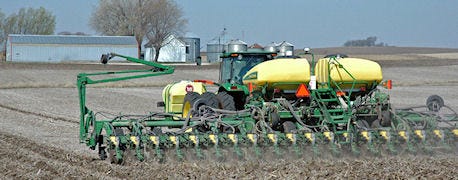
Farmers in Iowa may be the lucky ones this spring as the National Oceanic and Atmospheric Administration says they may escape the 5- to 6-foot-deep frost levels that will slow down planting in the rest of the northern Corn Belt.
NOAA's Spring Outlook report, issued Thursday morning, shows expected flooding in the Southern Great Lakes region due to above-average snowpack, while California continues to steep in continued drought. The forecast is effective from April through June.

NOAA Spring Outlook favors continued dry conditions in the West, delayed planting on deep frosts in Midwest
Producers in either area are likely displeased – NOAA says winter weather is likely to continue, bringing frozen ground and thick ice coverage in the upper Midwest and eastward. The continued cold temps are likely to push any flooding into April, but it is expected to be an issue.
"Rivers in half of the continental United States are at risk of exceeding minor or moderate river flood levels this spring, with the highest threat in Southern Wisconsin, Southern Michigan and portions of Iowa, Illinois and Indiana," Robert Hartman, Acting Director of the Office of Hydrologic Development, noted during a press call.
Related: Drought To Shrink In Midwest, But Continue In California
"Major" flood areas, NOAA says, will be centered on the Mississippi River and the Illinois River and others in the Missouri basin. Many have already experienced minor flooding this year, Hartman said. There is also risk of moderate flooding along the Red River of the North between eastern North Dakota and northwest Minnesota, he added.
Hartman noted that river ice formation may also create jams further south than normal, impacting river commerce. NOAA suggests an "elevated risk" of more ice jams in the North this spring, appearing from Montana all the way to New England.
Ice over the Great Lakes, Hartman said, has already reached record levels.
Drought persists in the West
Drought is expected to continue in California, where 99.9% of the state's area is in some form of drought, according to the U.S. Drought Monitor.
~~~PAGE_BREAK_HERE~~~
Below-average rains will also encourage drought to stick around in other Western states, such as Arizona, New Mexico, Colorado and Oklahoma. The onset of the dry season in April will likely allow drought to persist or intensify in the area. That could cause concern for livestock and crop producers who may be subject to water restrictions.
Related: Drought Intensifies in Far West, Across Great Plains
Washington, Oregon and some sections of Nebraska and Kansas are likely to improve, said Jon Gottschalck of the NOAA Climate Prediction Center. He added that drought is not expected east of the Mississippi in the next three months.
Impacts on agriculture continue
Gottschalk said much of the drought improvement centered on the Corn Belt and Iowa is due to normal spring rains, though models did not provide strong indication that drought relief would be long-term.
Spring planting also looks to be in good shape for the region. "From the perspective of spring planting, Iowa is in a part of the Corn Belt where if there are going to be no delays that might be it," USDA Meteorologist Brad Rippey said on the call.
"We have just a touch of lingering drought…it's the areas further to the north where the frost depths are so incredibly deep and we have more snow remaining that I think we are going to have spring fieldwork delays," he said.
Rippey noted that some delays may also linger into the Eastern Corn Belt, depending on how the spring plays out.
"It's really that Southwestern quadrant of the Corn Belt where we may not see quite the delays that we would expect elsewhere, given NOAA's monthly and three-month outlooks," he said.
Rippey added that though delayed planting is expected, it is unlikely that it will have a significant impact on crop yields. The real concern, he said, is in the West, where California's $45 billion agriculture industry could take a huge hit as a result of drought conditions.
"That would be the big concern – if fields lie fallow due to water restrictions," he said.
About the Author(s)
You May Also Like




